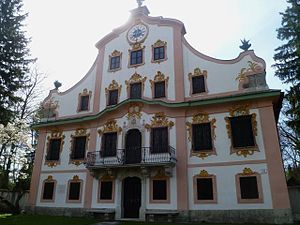Robinighof
| Robinighof | ||
|---|---|---|
|
Robinighof (rococo facade) |
||
| Creation time : | 1750 (first documented mention) | |
| Castle type : | Rococo castle | |
| Conservation status: | renovated, inhabited | |
| Place: | Schallmoos , Salzburg | |
| Geographical location | 47 ° 48 '52 " N , 13 ° 3' 41" E | |
|
|
||
The Robinighof is a baroque palace built in 1648 in the Schallmoos district of Salzburg (Robinigstrasse 35).
history
The Robinighof was first named Lodron by Archbishop Paris Lodron in 1648, shortly after the first major drainage measures in the Schallmoos , and in that year - like other courts of the Schallmoos - it came into the ownership of the Salzburg Cathedral Chapter. At that time it was still called Kochhof . In 1657 he was sold again to Bartlme Reiter for inheritance rights. In 1744 this farm was acquired by Georg Josef Robinig von Rottenfeld and converted into a rococo palace in 1750 according to plans by Franz Anton Danreiter . The farm is located on the eastern main drainage ditch of the Schallmoos, which is known today as the Lämmererbach. Danreiter was also a court gardener and had contributed to the construction of the Mirabell Gardens , so it was obvious to create a park here too. The iron merchant Robinig had classicist frescoes installed inside the house around 1785–1790.
In the house also was Wolfgang Amadeus Mozart , who was friends with the children of Robinig (Sigismund and Luise) family, often to visit. Sigmund Robinig (born September 5, 1787 Salzburg, † March 10, 1843 Salzburg) married the landlord's daughter Anna Maria Freudens- or Freudlsperger in 1818. Sigmund's widow (both only sons had died in the year of his birth) lived until 1851 and bequeathed the remaining fortune to a certain Karl Buxbaum. In 1885 Hermine Fahrner bought the property from his widow.
Robinighof today
The castle still has a magnificent rococo facade today. The side view shows a much simpler structure. The relief medallion above the entrance portal shows Saint Joseph and above it the coat of arms of the Robinig-Aniser. The property was fully restored in 2007. In front of the house there is also a late Classicist urn well worth mentioning with the inscription "Built by Maria v. Rubinich". The fountain has a simple design with a base and an urn placed on it, whereby it was pointed out that "the urn (shows) an aesthetic that corresponded to the former iron trade of the Lords of Robinig".
The old manorial road from the Linz main road to the castle and on to Lengfelden has been planted with trees on the Lämmererbach side since at least the early 19th century. A small remnant of this former row of trees forms what is now a protected part of the landscape. The protected part of the landscape of trees near Robinighof is 0.2 hectares and was placed under protection in 1991.
literature
- Martin Zehentner: Castles, manors and residences in Gnigl. In Sabine Veits-Falk; Thomas Weidenholzer (Ed.): Gnigl. Medieval mill village - parish on the railway - Salzburg district (pp. 226–241). District Association Gnigl and City Municipality of Salzburg (series of publications of the Archives of the City of Salzburg, vol. 29), Salzburg 2010.
Individual evidence
- ↑ Austrian Art Topography , ed. v. Art History Institute of the k. k. Central Commission for Monument Preservation, Volume XI, III. Part: Salzburg judicial district, Kunstverlag Anton Schroll, Vienna 1916, p. 100, available online at archive.org .
- ↑ Ulrich Nefzeg; Josef Darpa: Salzburg and its fountains. Residenz Verlag, Salzburg: 1980. ISBN 3-7017-0271-3 .
Web links
- Detailed description of the construction of the Robinighof in the Austrian Art Topography from 1916 on archive.org
- Information on salzburg.gv.at






